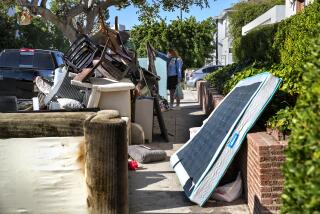Ring Around the Planet Is Floating Junk
- Share via
Moving into an English cottage some time ago, and trying to find out when to put out the garbage, I ran into a small language barrier.
“Garbage, madam?” repeated the councilman’s voice on the telephone. “Trash?” I suggested. “Trash?” he echoed. “Debris?” I tried. “You know, the stuff that’s left over that no one wants or knows what to do with,” I explained. “Oh, the rubbish!” the voice said heartily, “that is picked up Thursdays.”
Whatever the term, he knew quite well what I meant by my definition. Wherever people go, unwanted materials accumulate. (Many archeologists make their livings itemizing the contents of ancient rubbish bins.)
Not so long ago most of us dumped whatever we could not burn or bury into any body of water. But we know that doesn’t work. Even the coastal ocean isn’t big enough to absorb all of our refuse.
Although rocketry and the know-how to send man-made objects into orbit is only just completing its second decade, we have already filled the space around us with enough debris so that man-made objects outnumber asteroids.
The pollution of space has become a problem whose solution demands international cooperation. Space junk is already a factor to be considered when navigating any shuttle or space-station, or sending a new satellite into orbit.
Floating Debris in Space
When an object is jettisoned in space, it does not merely float away. Broken tiles, chips of paint, or shards of frozen sewage from the shuttle move in an orbit. Most are released within the Earth’s gravitational field and so ring the Earth.
They continue moving at whatever velocity they had when ejected, and that is often fast enough to cause damage should they collide with other, functioning, man-made objects. At the moment, NASA is tracking about 5,600 artificial objects, some of them large items like spent rocket stages or parts of exploded fuel tanks, as well as small items left behind by astronauts such as tools that they either let go of or discarded.
NASA is also keeping track of many dead satellites still in orbit. Eventually those that are low enough will spiral down until they enter, and are on the whole destroyed, by the Earth’s atmosphere.
More than half of the debris was made in America; another 40% is from the Soviet Union, and a small percentage comes from the extraterrestrial efforts of Western European countries and China.
Tracking Objects
Although tracking these sizable objects has begun to occupy an increasingly large amount of computer time at our space centers, it is the number of objects too small to be tracked, objects the size of a marble or smaller, that has become a more serious hazard.
These orbiting missiles, including billions of flecks of paint, are the product of either accidents or the deliberate destruction of objects of military value (the Soviets have contributed a great deal of debris this way).
In the case of the late Solar Maximus, a satellite not quite ready for retirement that was chosen by the Air Force as its target in the new laser weapons technology, zapping the scientific craft was a military and public relations coup. It did, however, leave in its wake at least a hundred tiny pieces of debris to contribute to the ring of garbage that has begun to encircle the globe.
Taking a Toll
There is evidence that this junk has already begun to take a toll. Jane’s Publishing Company warns in its Spacecraft Directory that space junk has caused some accidents and will continue to jeopardize commercial, as well as military, spacecraft.
As early as 1975, PAGEOS, a U.S. balloon satellite, was struck and damaged by small debris. Then in 1978, junk damaged the solar panels of GEOS-2, a European observation satellite. That same year a Soviet surveillance satellite fell over Northern Canada in a way that suggests it, too, had been struck by debris. There have also been recent incidents, such as the hundreds of holes made by flying paint chips that peppered the body of the 1984 shuttle carrying electronic boxes for the Solar Max Satellite.
Orbiting Junk
To this abundance of orbiting junk, entrepreneur Rafel Ross plans to add orbiting “cremains,” using space as the site for luxury “burials.” The outpouring of all this debris, unless halted, promises to form a ring around the Earth, a man-made asteroid belt, within the next generation.
How curious it is that just as we have begun to send probes to inform us about the make-up of the mysterious rings surrounding Jupiter and Uranus, we are creating our own peculiarly human kind of “halo.”
What if in the near future some extraterrestrials send their own probe to have a look at us. Imagine their dismay at discovering that the ring around the third planet from the star Sol is made of garbage. We will be lucky, under those circumstances, if they just turn around and leave us alone.
More to Read
Sign up for Essential California
The most important California stories and recommendations in your inbox every morning.
You may occasionally receive promotional content from the Los Angeles Times.













